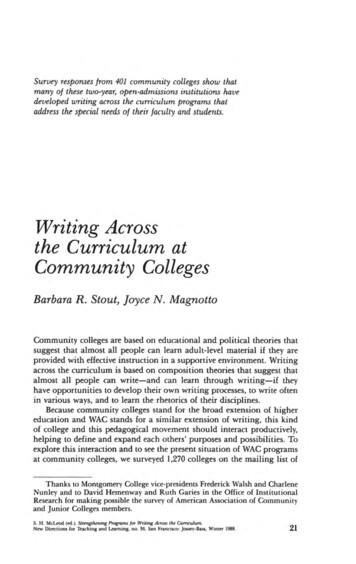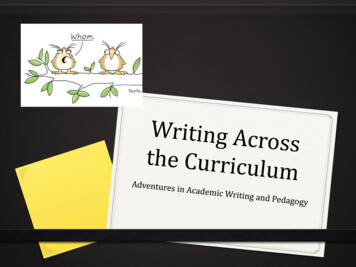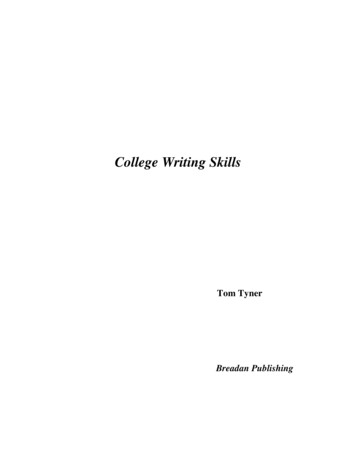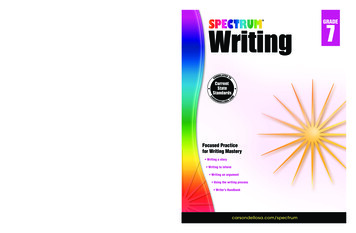
Transcription
Survey responses from 401 community colleges show thatmany of these two-year, open-admissions institutions havedeveloped writing across the curriculum programs thataddress the special needs of their faculty and students.Writing Acrossthe Curriculum atCommunity CollegesBarbara R. Stout, Joyce N. MagnottaCommunity colleges are based on educational and political theories thatsuggest that almost all people can learn adult-level material if they areprovided with effective instruction in a supportive environment. Writingacross the curriculum is based on composition theories that suggest thatalmost all people can write-and can learn through writing-if theyhave opportunities to develop their own writing processes, to write oftenin various ways, and to learn the rhetorics of their disciplines.Because community colleges stand for the broad extension of highereducation and WAC stands for a similar extension of writing, this kindof college and this pedagogical movement should interact productively,helping to define and expand each others' purposes and possibilities. Toexplore this interaction and to see the present situation of WAC programsat community colleges, we surveyed 1,270 colleges on the mailing list ofThanks to Montgomery College vice-presidents Frederick Walsh and CharleneNunley and to David Hemenway and Ruth Caries in the Office of InstitutionalResearch for making possible the survey of American Association of Communityand Junior Colleges members.S. H. McLeod (ed.). Strengthening Programs JOT Writing Across the Curriculum .New Directions for Teaching and Learning, no. 36. San Francisco: Jossey-Bass, Winter 1988.21
22the American Association of Community and Junior Colleges (AACJC)by means of a questionnaire administered by Montgomery College'sOffice of Institutional Research.We asked about activities, organization, funding, and benefits of WACprograms, and we elicited information about possible impediments toWAC at community colleges. We received 401 responses. In this chapter,we look at what those responses indicate about WAC at community colleges, and we highlight programs that meet the needs of two-year collegestudents and faculty.An Overview of WAC Programs in Community CollegesAlmost one third of the survey respondents reported that their collegeshave WAC programs. This percentage is consistent with other recentestimates of WAC programs at colleges and universities (see the Appendixin this volume and Kinneavy, 1987). Survey responses from 111 community colleges indicated that they are planning or considering writingacross the curriculum. The remaining 169 of the 401 responding collegesdo not have programs. Eleven reported discontinuing their programs,and one reported reinstating a program after a lapse.Community college WAC programs vary in longevity, organization,and funding levels. Nine respondents began WAC before 1979; fifty-twobegan between 1980 and 1984; sixty started between 1985 and 1987.Thirty-four plan to begin in 1988 and 1989.Some community college WAC programs are organized on a systemwide basis (for example, those in Minnesota and in Arizona's Maricopadistrict), but most operate at individual colleges. WAC is typically directedby a faculty member, although fifteen survey respondents reported management by an administrator. Multidiscipline WAC committees are common (eighty respondents), as are connections with core curricula orgeneral education (sixty respondents). A few colleges, such as LaGuardiaCommunity College in New York, have language across the curriculumprograms, in which writing is important but not primary.Funding for WAC ranges from the 600,000 in Bush Foundationgrants used to establish programs at the eighteen community colleges inthe Minnesota system to the annual budgets of 1,000 to 4,000 that arethe norm. Compensation for faculty members who direct WAC includesrelease time, varying from less than one course to full-time reassignment,and, less often, extra pay, ranging from 100 to over 3,000. A few programs have no funding and are fueled by faculty zeal or pushed by anadministrator. Fifty percent of respondents with WAC programs identifiedfunding as a concern (see Chapter Six).The most common faculty development activities are half-day workshops and informal, information-sharing sessions. Full-day workshops,
23longer institutes, and discipline-focused activities are also popular. Thethree WAC benefits most frequently cited on the survey are more studentwriting, increased student learning, and increased faculty interaction.As this overview indicates, community college WAC programs havemuch in common with programs at four-year colleges and universities,and this is consistent with their collegiate function (Cohen and Brawer,1987). Community colleges, however, often differ from senior institutionsin curricular dimensions, student characteristics, and faculty circumstances, and many community colleges have developed WAC activitiesespecially suited to their own realities.The Two-Year CurriculumCommunity college curricula are shaped by their two-year status andtheir "numerous tasks of . . . offering transfer, vocational, technical,adult, and developmental education. " (Cohen and Brawer, 1972, p. 7).With varied programs and no upper-division offerings, curricular dimensions at community colleges are more horizontal than vertical, to useJames Kinneavy's terms (1983, p. 13). Therefore, some WAC practicesthat were developed at four-year schools either are not useful at community colleges or must be adapted. Some respondents to our survey identified the two-year curriculum as a problem for WAC on their campuses,expressing a belief that writing-emphasis courses are more appropriatein upper-division programs and voicing a concern about limited time forstudent growth.Writing-Emphasis Courses. Obviously, community colleges cannotoffer upper-division writing courses such as those at the University ofMaryland and the University of Michigan. Several community colleges,however, have developed writing-emphasis courses and subject-composition courses, both of which can accelerate students' growth as writers. Inaddition, a few colleges have modified the usual two-semester freshmancomposition sequence.For example, at Broome Community College in New York, both writing-emphasis (W) courses and a second-year composition course areimportant components of a newly adopted general education program.To receive the associate's degree, Broome students must take two Wcourses after taking one semester of composition. Then, at the end oftheir curricula, students must take another semester of composition inwhich writing assignments are related to their specific fields. In thespring of 1988, Broome offered writing-intensive courses on a trial basisin computer science, mathematics, interior design, chemistry, business,dental hygiene, and nursing. Faculty receive stipends and course-loadreductions to develop their W courses; they also attend a seminar directedby WAC coordinators Patricia Durfey and Ann Sova.
24Linked Courses. A umber of community colleges offer linked orteam-taught subject- om osition courses to address the two-yea-r--c rncu lar limitation. Among the e colleges are Richland College and Houstonm.mJJ.Jlity College in Texas, Fullerton College in California, JohnsonCounty Community College in Kansa , Bucks County Community Col lege in Pennsylvania, Monroe Community College in ew York, andHarford and Prince Georges community colleges in Maryland. At PrinceGeorges, paired sections of Psychology 101 with English 101 and of His tory 101 with English 101 are offered. Students enroll in both classes, andassignments in the English composition course are directly connectedwith the psychology or history ourse. The instructors each receive threehours of released time during the planning semester to develop theirteam approach.The Technical and Vocational CurriculumMany community college faculty seem to believe that technical andvocational courses are not compatible with writing. In the survey, 154respondents checked "curricula in which writing is not usually assigned"as an impediment to WAC on their campuses. Again and again, com ments such as these appeared: "Community college vocational programhave few academic courses in their urricula and little opportunity forwriting in vocational courses," and "WAC seems le s adaptable totechnologies."These responses reflect a misunderstanding of major WAC principles,especially the concept of writing as an instrument of learning in anysubject. They also indicate the persistence of the assumption that tradi tional assignments, such as the research paper, are the only way to putwriting into a course. In addition, these comment eem to deny theimportance of writing in many of the careers for which community col lege students are being educated.WAC advocates believe that career cou.r es can (and should) preparegraduates for on-the-job writing. Cosgrove (1986) notes that communitycollege graduates perform a variety of writing tasks and that they find"two-year college courses in their major to be the most helpful to presentwork-related writing, ' with "English courses most helpful to academicand domestic writing" (p. iii). WAC programs can erve the technicaland vocational curricula integral to community colleges by emphasizingwriting to learn and writing that is likely to help graduates becomepromotable employees.For example, one of the country's strongest WAC programs dealsdirectly with technica.l classes. This program, Writing and Reading inthe Technologies (WRIT), is at Queensborough Community College(QCC) in ew York. WRIT has now expanded into the liberal arts at
25QCC, but it began in 1982 in vocational and technical programs. Itemphasizes journals and microthemes. WRIT provides faculty with several workshops each year, including some of a second-stage nature thathelp faculty continue to integrate writing into their classes. WRIT isdirected by Linda Stanley, who is supported by an assistant director anddepartment coordinators.The WAC program at Orange County Community College in NewYork also functions in technical and occupational courses, with creditbearing writing modules and writing workshops that are team taught bycomposition and technical faculty. Writing workshops are piggybackedonto courses in such fields as physical therapy and engineering science.Students take two of these modules to meet a three-credit, cross-disciplinary writing requirement. Christine Godwin is director.Student DiversityThe open-admissions policies of community colleges affect WAC programs. Around 40 percent of the nation's college students attend two-yearinstitutions ("Targeted Forecast," 1987; Commission on the Future ofCommunity Colleges, 1988), and these students are as diverse as the population of the United States. Some are well-prepared fledgling scholars,equal to their peers at selective universities; others arrive ill prepared forany kind of postsecondary study, academic or technical.Community college students often take classes part time; some havechildren; many have jobs. They spend little time on campus and so havefew opportunities for collaboration or conversations about their writingassignments. Without juniors, seniors, and graduate students as role models, community college students may not understand the commitmentand excitement of serious study, which inevitably includes writing.While these demographics should not and do not prevent communitycolleges from having WAC programs, respondents to our survey mostfrequently identified the following student characteristics as impedimentsto WAC on their campuses: job and family demands (cited by 44 percentof respondents), wide range of abilities or preparation (42 percent), andlittle time on campus (37 percent).The character of the community college student population has atleast three implications for writing across the curriculum. First, thisvariety of students benefits from a variety of writing assignments. WACdirectors can inform faculty about the many kinds of assignments thathelp students to learn course material as well as to become more practicedwriters. Second, community colleges need writing centers and other support services for student writers. Third, community colleges with effective-and sensitive-assessment and developmental programs have abetter chance of having strong WAC programs.
26Support for Student Writers. Writing centers that provide help withassignments in all subjects are particularly useful to community collegestudents. Survey respondents from 136 colleges reported writing centersat their campuses; 78 identified the lack of a writing center as a problemfor WAC.Community colleges often find that their lower-division statusprovides a staffing problem for writing centers. With no cohort of upperlevel students to work as tutors, centers are staffed by faculty, by freshmanor sophomore-level students, occasionally by students from nearbyuniversities, or by community members. Budgeting for faculty tutors andtraining for student tutors, who are seldom available for many semesters,are regular concerns. To address these problems, community collegeshave developed a variety of tutor-training programs and courses. Forexample, the State University of New York (SUNY) Agricultural andTechnical College at Farmingdale offers a special section of English 101(Composition) as a peer-tutoring course; students who have scored wellon the placement exam are invited to enroll, and those who complete thecourse satisfactorily can become paid tutors, helping fellow students withwriting assignments. Ann R. Shapiro developed this community collegevariation on Brown University's tutor-training course.Student workshops on such topics as essay exams, lab reports, andresearch papers are a support service provided at forty-nine collegesresponding to our survey. A few WAC programs (twelve respondents )help students through joint efforts with secondary schools. Examples areBrookdale Community College in New Jersey and Queensborough inNew York, which have sponsored conferences on writing and learningfor secondary school teachers.Assessment and Developmental Programs. Even the most devotedWAC faculty admit difficulty with students who have severe problemswith writing in standard English. Faculty and students alike are morecomfortable with writing when students can perform at the level expectedin any credit-granting course.At Miami-Dade Community College in Florida, improved studentplacement and emphasis on writing work together. Miami-Dade'sapproach to WAC has been through writing assignments in core curriculum courses. Students are expected to be prepared for writing because thecollege has strengthened its requirements for assessment, placement, andenrollment in developmental programs.The connection between developmental courses and writing acrossthe curriculum probably merits more attention. Only 7 percent of surveyrespondents reported revising developmental courses as a result of WAC.Students in such courses, however, need to practice all kinds of writing,particularly writing that will help them learn the material for all kindsof classes.
27Faculty CircumstancesWhile community college faculty share many characteristics with theirfour-year and university colleagues, these faculty teach under circumstances that often affect their attitudes toward and participation in WAC.Teaching loads are heavy at community colleges. The standard assignment each semester for a full-time faculty member is fifteen credit hours,which often means five classes and multiple preparations. An additionalclass or a few more credits are not unusual. Sometimes classes are large,with thirty or more students to be taught without the help of graduateassistants. Many community college faculty are convinced that they donot have time to assign and respond to student writing. On the survey,195 respondents (49 percent) checked "heavy teaching loads" as an impediment to WAC on their campuses.Community college faculty have not been expected to do research(although many do produce fine scholarship). Doctoral degrees and publishing records are not critical to their hiring, promotion, and tenure.This situation provides both positive and negative potential for WAC.The positive is that community college faculty, free from the pressure topublish, may have some energy to devote to student writing. The negativeis that many community college faculty are not writers themselves andmay not be comfortable dealing with writing in their classes (Ohler,1985). This situation is an interesting inversion of that at research universities. In addition, like their four-year colleagues, community collegefaculty are specialists who sometimes have problems with "terminology,personality, and turf" (Fulwiler, 1984, p. 114) when writing is encouragedin all curricula.Our survey shows that several community college WAC programsdeal directly with the realities of heavy teaching loads, faculty uncertaintyabout writing, and specialization by using intensive institutes, one-toone consultation, discipline-specific activities, and resource materials.Intensive Faculty Institutes. The Minnesota colleges, Richland College and El Paso County Community College in Texas, and the MaricopaCommunity College District in Arizona are among those that have beenable to provide intensive WAC institutes, which feature composition theory, easy-to-grade assignments, and faculty writing experiences. Richlandhas annual two-day workshops; El Paso County has a semester-long program with weekly seminars. In the summer of 1987, faculty from allseven Maricopa campuses participated in a two-week session modeledafter National Writing Project summer institutes, with stipends and graduate credit. These faculty reviewed scholarship in their fields, both toupdate themselves and to learn what kinds of writing were being used intheir subjects. They also wrote and participated in writing groups, gaining or regaining a feeling for the pain and pleasure of writing, a sensi-
28tivity important to using writing well in classes. The Maricopa project isdescribed in " Writing: A Way of Learning" (Bertch, 1987). Julie Bertchis director.One-to-One Consultations. At North Shore Community College inMassachusetts, WAC committee members have used a one-to-one consulting approach, meeting individually with faculty in various disciplines tohelp them develop and respond to writing assignments. Marion Bailey isdirector. Clinton Community College in New York reports a similarapproach.Discipline-Specific Activities. Sixty-two survey respondents said thattheir WAC programs have included department- or discipline-focusedactivities. At Montgomery College in Maryland, WAC in its second stagewill focus on writing in science, mathematics, and related programs in1988, on writing in business, management, and related programs in 1989,and on writing in the humanities, the arts, and related programs in 1990.This approach was developed in consultation with faculty in eachdiscipline.Resource Materials. Books, with copies of assignments from all kindsof courses, can assist faculty in both technical and academic classes; suchbooks are particularly helpful to part-time faculty. Colleges with goodresource materials include Quinsigamond (in Massachusetts), Minneapolis Community College, Queensborough, and Miami-Dade.Other Faculty Support Activities. Some community colleges encourage faculty writing by organizing writing groups and giving luncheonsor teas honoring faculty writers. A few colleges give other assistance:Chesapeake College in Maryland provides a writing hot line for facultyand staff; Miami-Dade has used paid, trained "collateral readers" fromthe community to help in evaluating and grading papers. Orange County's Consultancy Project provides writing consultants for technical departments and for individual faculty who request them.Support for Part-Time Faculty. In the survey, 101 respondents (25percent) said that the employment of large numbers of part-time facultycreates a problem for WAC on their campuses. It is often difficult toattract part-time faculty to WAC presentations and workshops; they areoften not well paid and usually have other jobs, so they seldom come tothe college apart from their teaching times. Helping part-time instructorsuse writing well in their classes can be an important WAC goal. Distributing resource materials among part-time faculty, scheduling eveningand weekend workshops, and assigning full-time faculty mentors arepossible methods for improving the situation.Planning for the Second StageCommunity colleges are moving into the second stage of writingacross the curriculum on two levels. Colleges now beginning programs
29are building on the experiences of those with established programs.Colleges with continuing programs are using the strategies presentedthroughout this sourcebook as they evaluate what they have accomplishedand what they plan for the future. Both groups can take advantage of thenatural affinity of WAC with the teaching mission of the communitycollege. WAC programs at community colleges can emphasize writing tolearn, writing that prepares students for work or transfer, and writingthat enriches students' lives.Community college WAC programs should be increasingly involvedwith employers, composition programs (including developmental components), and secondary schools. Faculty and administrators need toknow more about the writing demands in the careers for which theytrain students; only six respondents identified " increased interactionwith employers" as a WAC benefit. Composition sequences should bereexamined. Colleges should collaborate with secondary school systemsto increase continuity in writing experiences (see Chapter Five).In the future, community colleges will have a hard time avoidingwriting across the curriculum. Not only will transfer students write inupper-division courses, but, because "there is virtually no occupation inour society today that does not require literacy of its employees, . thechallenge to read and write must permeate the curriculum" (Roueche,Baker, and Roueche, 1987, p. 25). The report of the Commission on theFuture of Community Colleges (1988) says that "above all [the colleges]should help students achieve proficiency in written and oral language"in all classes (p. 47). Finally, government agencies are now involved.The Maryland State Board of Community Colleges' recent report Blueprint for Quality (Committee on the Future of Maryland CommunityColleges, 1986) recommends writing across the curriculum, and Floridahas legislated writing into its community colleges' curriculum.More idealistically, we see writing across the curriculum as demonstrating the " vision and grit" that our community colleges embody(Stimson, 1987, p. 39). WAC is based on visions of learning and literacy,and WAC programs across the country are showing the grit needed toextend higher education to a wider community.ReferencesBertch, J. " Writing: A Way of Learning." Innovation Abstracts (National Institute for Staff and Organizational Development, University of Texas at Austin),1987, 9 (15).Cohen, A. M., and Brawer, F. B. Confronting Identity: The Community CollegeInstructor. Englewood Cliffs, N.J.: Prentice-Hall, 1972.Cohen, A. M., and Brawer, F. B. The Collegiate Function of Community Colleges:Fostering Higher Learning Through Curriculum and Student Transfer. San Francisco: Jossey-Bass, 1987.
30Commission on the Future of Community Colleges. Building Communities: AVision for a New Century. Washington, D.C.: American Association of Community and Junior Colleges, 1988.Committee on the Future of Maryland Community Colleges. Blueprint for Quality. Annapolis: Maryland State Board of Community Colleges, 1986.Cosgrove, C. "The Writing of Two-Year College Graduates: An Examination ofthe Writing Activities of Alumni from Two Western New York Institutions."Unpublished doctoral dissertation, State University of New York, Buffalo,1986.Fulwiler, T. " How Well Does Writing Across the Curriculum Work?" CollegeEnglish, 1984, 46 (2), 113-125.Kinneavy, J. L. "Writing Across the Curriculum." In P. Franklin (ed.), Profession83. New York: Modern Language Association, 1983.Kinneavy, J. L. " Writing Across the Curriculum." In G. Tate (ed.), TeachingComposition: Twelve Bibliographical Essays. Fort Worth: Texas Christian University Press, 1987.Ohler, S. "Writing Across the Curriculum Practices of Full-Time Faculty inSelected Community Colleges." Unpublished doctoral dissertation. Universityof Texas at Austin, 1985.Roueche, J. E. , Baker, G. A. , III, and Roueche, S. "Open Door or RevolvingDoor: Open Access and the Community College. " AACJC Journal, April/May1987, pp. 22-26.Stimson, C. R. "Who's Afraid of Cultural Literacy?" Community College Humanities Review, 1987, 8, 39-46."Targeted Forecast: Higher Education Enrollment." Chronicle of Higher Education, November 25, 1987, p. A29.Barbara R. Stout is professor of English and coordinatorof writing across the curriculum at Montgomery College,Rockville, Takoma Park, and Germantown, Maryland.Joyce N. Magnotta is associate professor of English studiesand director of writing across the curriculum at PrinceGeorges Community College, Largo, Maryland; she alsoserves on the board of consultants of the National Networkof Writing Across the Curriculum Programs.
County Community College in Kansa , Bucks County Community Col lege in Pennsylvania, Monroe Community College in ew York, and Harford and Prince Georges community colleges in Maryland. At Prince Georges, paired sections of Psychology 101 with English 101 and of His tory 101 with English 101 are offered. Students enroll in both classes, and











